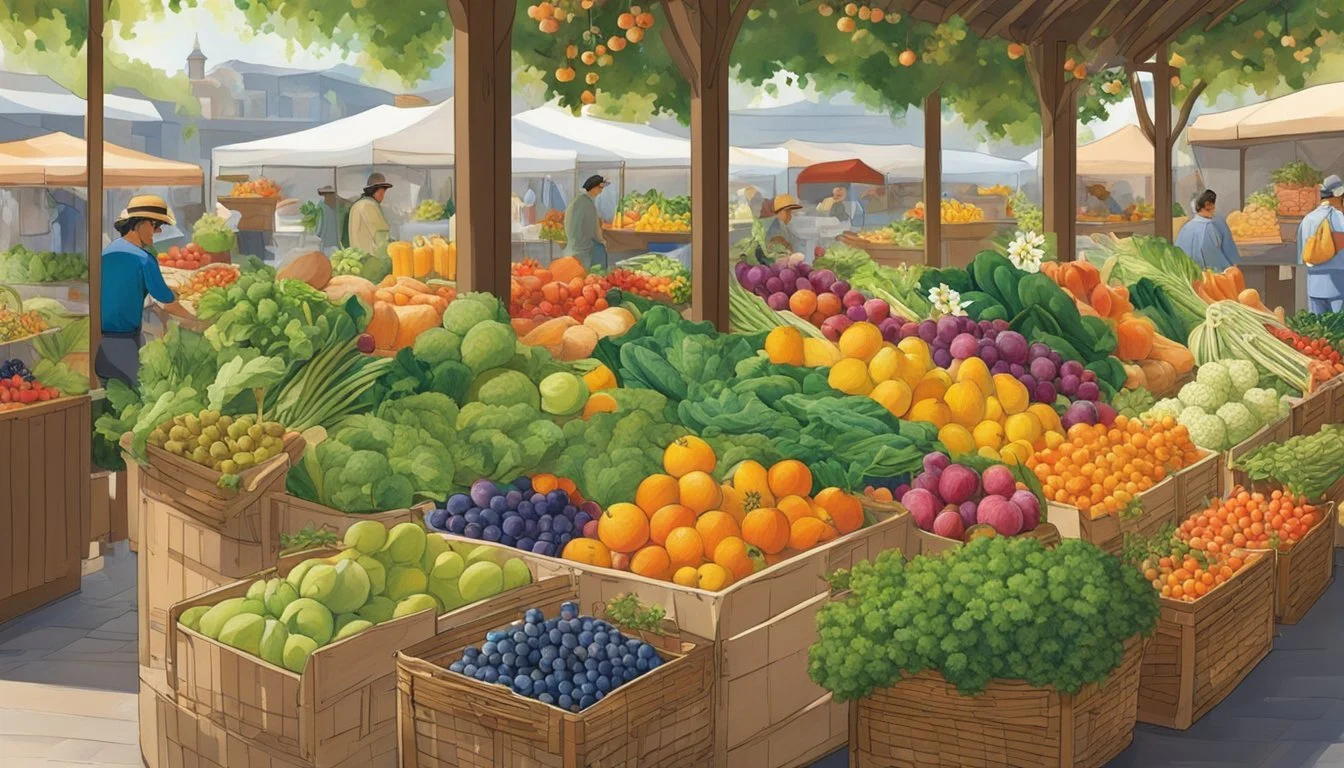Farmers' Market Shopping List
Essentials for Every Season - Your Guide to Year-Round Fresh Finds
Farmers' markets offer a vibrant showcase of local agriculture, presenting a diverse array of fresh and seasonal produce that supports local farmers and the community. Stepping into the bustling aisles, shoppers are greeted with the rich colors and enticing aromas of just-picked fruits and vegetables. To make the most of this healthy and sociable shopping experience, a well-prepared shopping list is essential. It not only ensures that one buys the best of what's in season but also helps in planning meals that are both nutritious and flavorful.
Navigating the farmers' market effectively requires understanding what produce is available during each season. Spring heralds the arrival of tender greens and sweet peas, while summer offers a bounty of berries and stone fruits. Fall brings root vegetables and hearty squashes into the spotlight, and winter provides robust citrus and leafy kale. Armed with this knowledge, shoppers can tailor their lists to include seasonal staples as well as more unique offerings that may capture their interest.
Beyond produce, farmers' markets also provide artisanal cheeses, local honey, fresh-baked goods, and handcrafted preserves, rounding out the possibilities for well-planned meals. To engage fully with the farmers' market experience, shoppers will benefit from bringing reusable tote bags to carry their purchases and taking the opportunity to connect with vendors, learning directly about the origins of their food. This connection reinforces the importance of supporting local producers and contributes to the thriving ecosystem of the community market.
Understanding Farmers' Markets
Farmers' Markets serve as a critical nexus for fresh, seasonal produce and support the backbone of the local food economy. By directly connecting consumers to local farmers, these markets not only boost the local economy but also offer higher-quality, nutrient-rich foods.
The Importance of Supporting Local Farmers
Shopping at farmers' markets directly supports local farmers and, by extension, the local economy. When consumers purchase from these small-scale producers, they help sustain agriculture within their region, ensure money stays within the local community, and support the viability of local businesses. Moreover, local farmers often employ practices that prioritize quality and use fewer or no pesticides, providing access to a variety of organic produce.
Economic Impact: Every dollar spent at a local farmers' market can have a multiplier effect, significantly benefiting the local economy.
Agricultural Preservation: By buying locally, consumers help protect the farming heritage of their region and ensure the continuation of crop diversity.
Seasonal Shopping: Why It Matters
Seasonal shopping is a practice that aligns consumer habits with the weather cycles of their local area, resulting in fresher, more nutrient-rich fruits and vegetables. This approach reduces food miles and, correspondingly, the carbon footprint associated with transporting food. Additionally, eating seasonally means that foods have likely not been stored for long periods, preserving their flavor and nutritional content.
Health Benefits: Seasonal fruits and vegetables are harvested at their peak and are packed with more nutrients than off-season counterparts.
Environmental Resilience: Choosing seasonal produce contributes to lower carbon emissions and promotes a more sustainable food system.
Planning Your Visit to the Farmers' Market
When visiting a farmers' market, one should have a clear plan and shopping list that cater to the season, knowledge about local markets and vendors, and budget-friendly shopping strategies. These steps can ensure a successful and efficient market experience.
Researching Local Markets and Vendors
To begin with, researching local farmers' markets is crucial. Shoppers can find valuable information on sites like Local Harvest or by engaging with social media platforms where vendors may announce their offerings. One should look for markets that align with their meal plan needs and preferences. When choosing vendors, consider their farming practices, the variety of produce they offer, and their presence at the market throughout the season.
Creating a Seasonal Shopping List
Creating a focused shopping list is imperative for market visits. Seasonal produce often dictates what's available, so one's weekly meal plan should adapt accordingly. Utilize resources like seasonal food guides to identify the best deals on high-quality, peak-season items. This can not only add freshness and variety to one's meals but also help save money by purchasing abundant, in-season produce.
Budgeting Tips for Market Shopping
Having a budget in mind when visiting a farmers' market can lead to more thoughtful purchases. Here are a few tips to help manage spending:
Know your limits: Set a budget before you go and stick to it.
Prioritize purchases: Invest in staple items needed for your meal plan first.
Bargaining: Some vendors are open to bargaining, especially towards the end of the day.
Bulk buying: Sometimes, buying in bulk can save money in the long run, but make sure it aligns with your menu so nothing goes to waste.
By applying these strategies, shoppers can make the most of their farmers' market experience, obtaining the best deals while ensuring they are selecting the freshest ingredients for their seasonal meals.
Essentials for Your Market Trip
When preparing for a farmers' market trip, shoppers should focus on two crucial aspects: the means to carry their purchases and the form of payment. These necessities ensure a smooth and efficient shopping experience.
Reusable Bags and Containers
One should bring reusable bags and containers to the farmers' market. Not only do these reduce waste, but they also provide sturdy and reliable means to transport fresh produce and other items. Shoppers may prefer:
Canvas Totes: Durable and washable, ideal for heavy items.
Mesh Produce Bags: Lightweight and see-through, these bags help keep fruits and vegetables organized.
Glass or Plastic Containers: Useful for delicate berries or leafy greens to prevent crushing.
Carrying Cash and Making Payments
Many market vendors prefer or only accept cash as a form of payment. Shoppers should ensure they have small bills and change for transactions. While some vendors might sport a card reader, cash often expedites the payment process, and it is beneficial for:
Exact Change: This can quicken the checkout process.
Small Purchases: If one is buying a single item, cash transactions can be more convenient.
Taking these items on a market trip can greatly enhance the shopping experience by ensuring one has all the essentials to buy fresh and local produce without any hassle.
What to Buy Each Season
When visiting a farmers' market, selecting seasonal produce ensures peak flavor and nutrition. The following guide details when to look for specific fruits and vegetables throughout the year.
Spring Selections: Green and Growing
Spring welcomes a variety of tender, leafy vegetables and the first sweet fruits of the year. Strawberries make their bright and juicy arrival, perfect for fresh eating or incorporating into desserts. Artichokes (What wine goes well with artichokes?) and kale are also at their best, offering a combination of texture and earthy flavors to spring dishes. Rhubarb, with its tartness, emerges in this season, often used in pies and jams.
Artichokes: Tender with a deep, nutty flavor.
Strawberries: Sweet and fragrant, ideal for salads and jams.
Kale: A versatile green, rich in vitamins and minerals.
Rhubarb: Tart, often paired with sweet ingredients in dishes.
Summer Harvest: Bright and Bold
Summer is the time for vibrant vegetables and succulent fruits. Markets are abundant with corn, its sweet kernels perfect for grilling or in salads. Blueberries and peaches, bursting with flavor, are excellent for baking or as a natural sweetener in cereals or yogurts. Zucchini and cucumbers are refreshing and hydrating, while peppers, ranging from sweet to fiery, add a punch to any meal.
Corn: Sweet and buttery, a staple for summer cookouts.
Blueberries: Juicy and antioxidant-rich, a great snack or topping.
Peaches: Fleshy and sweet, ideal for pies and cobblers.
Zucchini and Cucumbers: Crisp and versatile for both raw and cooked dishes.
Peppers: Diverse in flavor, from sweet bell peppers to spicy chilis.
Autumn Offerings: Warm and Earthy
As the air turns crisp, farmers' markets begin to fill with sweet potatoes, beets, and earthy nuts such as walnuts and pecans. Apples are also a staple in autumn, with a variety of types available for eating raw or baking. Autumn is the time to savor the deep flavors and hearty textures of the season.
Sweet Potatoes: Nutrient-dense and versatile, ideal for roasting or mashing.
Beets: Rich in flavor and color, perfect for salads or as a side dish.
Nuts: Walnuts and pecans add crunch and nutrition to dishes.
Apples: Available in many varieties, from tart Granny Smith to sweet Honeycrisp.
Winter Finds: Hearty and Wholesome
Winter calls for robust produce that withstands the cold. Root vegetables like carrots and celery are staples, great for stews and stocks. Citrus fruits offer a necessary burst of vitamin C and can brighten up the dark winter days. Additionally, many leafy greens such as kale can survive frost, making them sweet and tender.
Carrots and Celery: Hardy and flavorful, essential for comfort food recipes.
Citrus: Oranges, lemons, and limes providing fresh flavors and vitamins.
Kale: Hardy greens that can become sweeter after a frost, perfect for salads and sautés.
Maximizing Your Market Experience
Visiting a farmers' market is about more than just grocery shopping; it's an opportunity to immerse oneself in local flavors and artisanal craftsmanship. To truly maximize one's experience at the market, shoppers should focus on two key activities: sampling local delicacies and learning from artisans and growers.
Sampling Local Delicacies
Farmers' markets offer an abundance of fresh produce and unique local specialties. They should first make it a point to taste various samples provided by the vendors. Tasting allows them to discover new flavors and products they might not find elsewhere. Tasting also provides an opportunity to discuss cooking techniques and recipes directly with the source, as many vendors are more than happy to share their knowledge on how best to prepare their offerings.
Taste different samples: Fruits, cheeses, dips, and baked goods
Discuss recipes: Ask for cooking tips for unfamiliar items
Learning From Artisans and Growers
Education is a huge part of the market experience. Shoppers can engage with local farmers and vendors to learn about the origin of their produce, the process of craft, and the best storage methods for fresh produce to ensure longevity and taste. Building relationships with the people behind the local businesses can lead to a deeper understanding of where food comes from and elevate one’s cooking with truly fresh ingredients.
Ask questions: Learn about sustainable practices and harvesting techniques
Build relationships: Gain insights into the peak season for various produce
Beyond Fruits and Vegetables
While fruits and vegetables may be the stars of the farmers' market, a variety of other local goods are on offer to provide a comprehensive shopping experience.
Local Meats, Eggs, and Dairy
Farmers' markets often feature vendors selling locally raised meats including beef, pork, chicken, and sometimes less common varieties like bison or lamb. Fresh eggs are usually available from free-range chickens, providing a richer flavor than store-bought options. Artisanal cheeses offer an array of flavors and textures unavailable in commercial brands.
Artisanal Breads, Jams, and Preserves
The smell of freshly baked bread often permeates the market air, with options ranging from classic sourdough to gluten-free loaves. Stalls typically brim with an assortment of homemade jams and preserves, featuring seasonal fruits and sometimes unexpected combinations. These handmade products capture the essence of the season and are made without the preservatives found in many commercial brands.
Homemade Sauces and Specialty Items
Shoppers should keep an eye out for homemade sauces, such as salsa, pasta sauces, and barbeque sauces, all crafted with fresh ingredients and often following family recipes. Specialty items can include items like locally harvested honey, hand-picked spices, and an assortment of nuts. Beverages like freshly squeezed juice, artisan coffee, handcrafted tea blends, local wine, and kombucha are frequently available for those seeking refreshing drinks or unique alcoholic beverages. Moreover, many markets offer fresh herbs, essential for cooking, and seafood or fish—local and fresh if near the coast.
Storing and Preparing Your Market Finds
Once fresh produce is brought home from the farmers' market, efficiently storing and preparing the items can vastly enhance their shelf-life and flavor when it comes time to cook. Proper planning ensures optimal nutrition is retained and that the food will be used to its fullest potential.
Proper Food Storage Techniques
Vegetables and fruits require different storage methods to maintain their freshness. Vegetables like leafy greens should be washed, patted dry, and stored in produce bags within the fridge. Root vegetables, on the other hand, are best kept in a cool, dark place. Berries should be removed from their original containers, checked for any spoiled pieces, then lined with paper towels and stored in the fridge.
Containers: Airtight containers are ideal for leftovers or cut produce.
Nutrition: Refrigeration slows down the loss of essential nutrients.
Innovative Meal Prepping with Seasonal Ingredients
Creating a meal plan to incorporate seasonal ingredients from the farmers' market promotes variety and ensures that nothing goes to waste. Turn ripe vegetables into a hearty stew or risotto, which can also be frozen for later use. Use overripe fruits to make jams, or bake them into desserts.
Cooking Tips:
Utilize vegetables like onions, carrots, and celery to make a flavorful vegetable stock.
Incorporate bacon or dried beans in recipes for additional protein and flavor.
Recipes:
Stews and risottos can easily integrate a diverse mix of market finds.
Use leftovers to create new meals, like blending vegetable scraps into a soup or adding them to omelets.
By understanding the characteristics of each item and considering potential recipes during storage, shoppers can enjoy their farmers' market purchases at the peak of freshness and nutrition.
Engaging with the Community and Environment
Shopping at farmers' markets enables individuals to actively participate in their local economy and make environmentally conscious choices. This engagement has tangible benefits for both the community and the surrounding environment.
Participating in the Local Economy
When consumers buy directly from farmers' markets, they are supporting local farmers and producers. This sustains livelihoods and keeps money within the community. The direct transaction eliminates the need for middlemen, ensuring that a greater percentage of the profit goes straight to the producers themselves.
Economic Benefits:
Support for Local Farmers: Keeps money in the local community.
Job Creation: Contributes to the local job market as markets require staff and support services.
Reducing Environmental Impact
Choosing to shop at farmers' markets can lead to a smaller carbon footprint. The food miles — the distance food travels from production to consumer — are significantly reduced. This reduction occurs because products sold are often grown or produced within a close radius to the market.
Environmental Benefits:
Less Packaging: Often, goods are sold with minimal to no packaging, reducing waste.
Lower Emissions: Shorter travel distances mean fewer emissions from transportation.
Sustainable Practices: Farmers' markets frequently offer organic and pesticide-free options, reflecting sustainable farming methods.
Every purchase at a farmers' market is a step toward a more self-reliant community and a more sustainable world.









